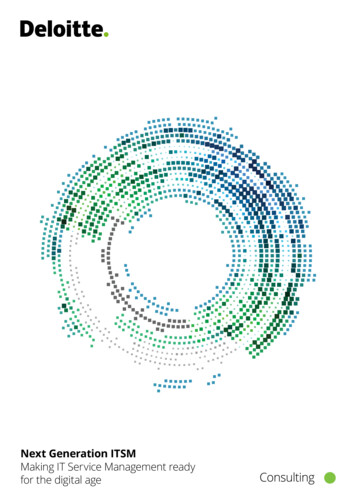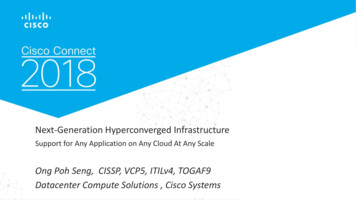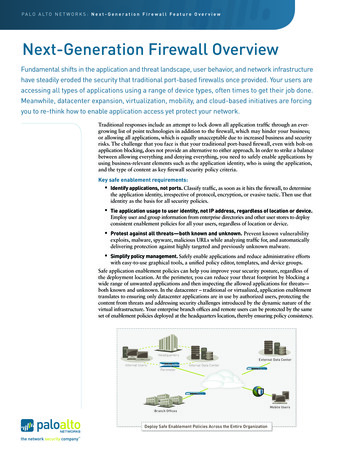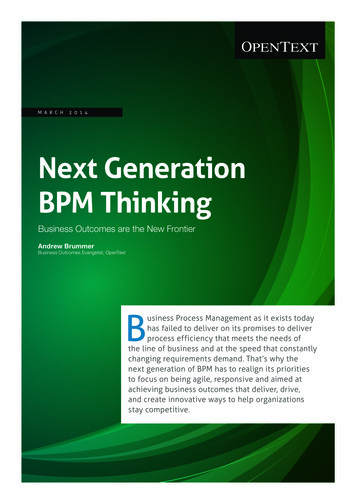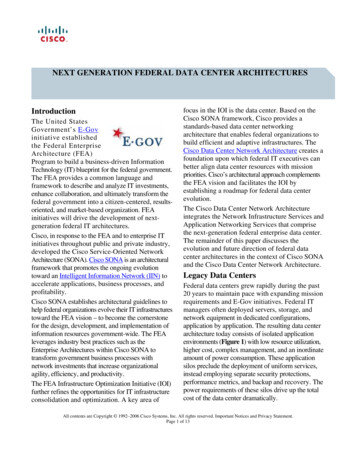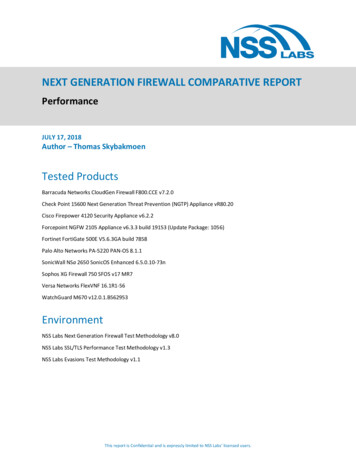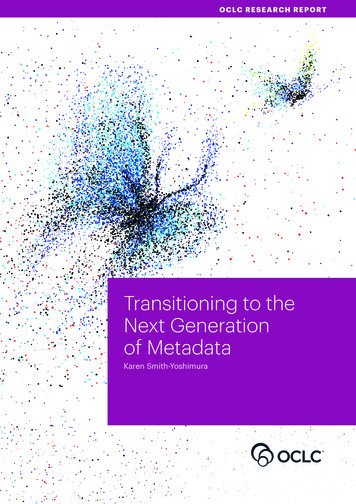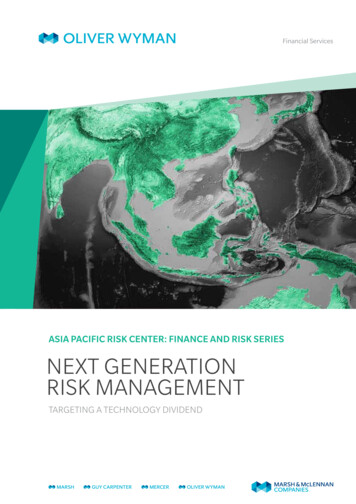
Transcription
Financial ServicesASIA PACIFIC RISK CENTER: FINANCE AND RISK SERIESNEXT GENERATIONRISK MANAGEMENTTARGETING A TECHNOLOGY DIVIDEND
THE RISK MANAGER’S CONUNDRUM:BEING ASKED TO DO MORE WITHLESS, IN A MORE UNCERTAIN WORLDCopyright 2017 Oliver Wyman1
Many drivers are shaping the context of risk management today. Macroeconomicheadwinds, global geopolitical uncertainty, and ever more frequent and damaging cyberevents have been in the vanguard of challenges leading to heightened risk perceptions.At the same time, investment in risk management is under pressure. The changes inbanking regulation, to address shortcomings highlighted by the Global Financial Crisis,have transitioned from the uncertainty of planning stages to implementation; thesecoupled with low productivity growth are pressuring returns.MACROECONOMIC HEADWINDSMacroeconomic headwinds driven by global and Asian debt levels,1 low growth,anti-globalization sentiments, increasing policy uncertainty and the hike in US interestrates, represent significant challenges. These challenges are particularly pronouncedfor export-dependent economies, which comprise most of Asia. As the saying goes,if China catches a cold, so does the Pacific and Australasia. Concurrently, many leadingeconomies in Asia Pacific such as China, Singapore, and Australia are struggling tomaintain labor productivity and productivity growth. Productivity-enhancing policies arerequired, including capital investments in new technology and workforce development.New productivity strategies will require modifications to risk management. Risk teamsneed to use their established capabilities to anticipate potential implications of thiscontext, and develop new capabilities for managing risks arising from new technology.NEW AND HIDDEN RISKSGlobal perceptions of risk, as measured in Oliver Wyman’s annual work with the WorldEconomic Forum,2 are more elevated than ever. Moreover, the interconnectedness of riskscompounds their impact – geopolitical risks mean that economic shocks are both more likelyand potentially more severe than previously.At the same time, technological advancements (such as open banking, online/mobileplatforms) are exposing institutions to emerging risks such as data fraud and cyber securitythreats, with a stark reminder served by the WannaCry and Petya ransomware attacks.Cyber threats while not a new area of risk for financial institutions represent a significantcost, with the cost of cyber-attacks forecasted to rise from 81 billion in 2016 to 2.1 trillionby 2019.3 Strategic risk from technology that can disrupt business models also needs closeattention: the “unicorns” of the digital age may become the “model T” to banking’s horse.1 Asian Nations Swimming in Debt at Risk from Fed Rate Hikes. Bloomberg 20172 The Global Risks Report 2017, 12th Edition3 Asia Pacific Risk Center Marsh & McLennan Companies, 2017. Cyber Risk in Asia-PacificCopyright 2017 Oliver Wyman2
THE RENEWED REGULATORY LANDSCAPEA “deluge of regulation” has followed the dramatic events of the Global Financial Crisis.This has created substantially increased expectations of risk management as well as raisingthe financial cost of risk-taking for supervised entities. Asia Pacific regulators are followinginternational precedent with increased oversight of multiple areas including stress testing,recovery and resolution planning, cyber resilience, as well as new regulations in requiredcapital estimation. These increasing regulatory requirements have forced banks to ramp upcompliance activities, placing pressure on risk management resourcing.The result of this context is that risk teams are being asked to do more with less, in a moreuncertain world. Where regulators have agreed extra steps need to be taken to protectdepositors and taxpayers, risk teams are asked to execute while constraining cost growth.Where the business landscape seems more uncertain, with dramatic changes comingfrom technological sources, risk teams are again expected to anticipate and solve fornewer uncertainties with the same capacity. A productivity gain in risk is a critical piece inaddressing this conundrum, and technology must play a key role.Copyright 2017 Oliver Wyman3
TARGETING ATECHNOLOGY DIVIDENDCopyright 2017 Oliver Wyman4
While radical technological change is part of the problem for risk management – at leastin terms of the strategic threats and risks, such as the implications of cyber risks – it mustalso be part of the solution. Technological advancements offer a substantial opportunity forthe risk function to target efficiency gains. Risk must target a technology dividend in orderto maintain “match fitness” and build new capabilities, to address rising demands withlimited resources.Advanced analytics, non-traditional data, natural language processing, together withprocess digitization, present compelling opportunities for risk management. This includesraising productivity, greater insights produced from new technology, and potentiallyachieving a competitive advantage in a digital world. Although cashing in on a technologydividend in this way presents a compelling prize, it will require wholesale change in currentpractices. Senior leadership focus and support is critical as multiple functions will need tolearn new skills and change their habits.Getting the most from targeting a technology dividend for risk will require:1. Comprehensively mapping the potential for efficiency gains across risk processes2. Understanding competitive landscape and relative position to peers in use of digitalrisk tools3. Targeting horizons of digital ambition for future risk management4. Anticipating, in planning the pathway, implications for long-term talent needs and hiringand developing early5. Ensuring consistency of the digital risk plan with global and local regulatory expectationsand upgrading regulatory engagement to partner effectively on the journeyThere are a myriad of places in the day-to-day activities of risk management where gainscan be realized through the use of technology. It is vital to avoid a “boil the ocean” exercise.Instead, the adopted approach must be practical and affordable in the current businessclimate. A critical first step is to identify the priority opportunities. We recommend threemajor levers be considered to evaluate potential opportunities across the risk value chain,with the objective of targeting 2-3 initiatives to kick-start a broader technology pivot:Data: Financial institutions typically suffer an embarrassment of riches with data; specifically,masses of data, but too many “sources of truth” leading to confusion, with new sourcesbeing added constantly. Banks need to materially invest in organizing their data so they canboth generate deeper insights from “old” data, and gear their risk processes to benefit fromnew sources. New sources need to be considered, from cloud accounting, through to APIsfor Open Banking, to social media, geolocation, rainfall, shipping, and more.Analytics: Machine learning and other advanced analytics have become affordable andreadily available. They are already providing dividends through applications in underwritingand collections. Developing an advanced analytics capability is table-stakes.Processes: Time-to-money in banking is still too-often 20 days or more, even withdigital banking products where real time decisions or pre-approved limits are available.Credit underwriting is just one of many risk processes where digitization offers significantopportunities for efficiency gains.Copyright 2017 Oliver Wyman5
DATAData are being created at unprecedented volumes – over 90 percent of data currentlyavailable was created in the last five years. As the ability to manage and access this data hasbecome better and cheaper, organizations are exploring the use of varied and novel datasources to unlock greater insights. Financial institutions are already incorporating such datainto the analysis of credit assessment, AML/KYC,4 and collections.Concurrently, there is a drive for greater data openness – for example, both the Australianand Singapore government have launched portals that enable public access to data fromgovernment agencies,5 and are promoting Open Banking and ever greater transparency.As part of the ASEAN Banking Integration Framework, the Philippines, Malaysia, Thailand,and Indonesia have entered into various agreements to open up the banking industry withgreater financial integration across South-East Asia.However, many banks are only scratching the surface of how they use internal and externaldata. For example, significant improvements in efficiency can be achieved through bettermining of existing data within transaction accounts and other internal databases. A furtherboost from incorporating external data sources including Open Banking and beyond(e.g. social media, energy, telco, and retailers, and other financial services such as paymentsinterchanges) will become the standard for risk insight generation in time, but need notbe an immediate priority. Irrespective of the approach chosen to progress in improvingdata management, it is critical to select a use case. A good example is early warning ofdeterioration in credit quality.4 Anti-Money Laundering (AML) and Know Your Customer (KYC)5 Open data is the free use of data without restrictions from copyrights, or other mechanisms of control. For example, governmentwebsites publish public data in Australia (data.gov.au) and Singapore (data.gov.sg)Copyright 2017 Oliver Wyman6
CASE STUDY 1DATA TO ENHANCE CREDIT “EARLY WARNING”Many banks face challenges in proactively identifyingnon-performing clients. Typically, this is driven bytraditional rating models, which rely on financial data(for example, balance sheet information, and creditbureau reports), and qualitative information provided byrelationship managers. Financial factors are calculatedannually, requiring detailed financial spreading analysis,leading to significant workload and cost. Non-financialfactors are typically determined by the branch andunderwriting teams through manual and subjectiveanalysis. None of this provides a real time, forwardlooking view.In addition to ratings, banks monitor early warningsignals of potential worsening of client creditworthiness.These typically include stock-price or sector alerts,or proxy indices. Although these types of indicatorsprovide valuable insights on increased risk for eachclient, their horizon is often too short to take anypre-emptive action. Corrective action requires a setof more forward-looking indicators.Transaction data, social media, and other sourcescan drive much closer to real time customer level riskinsights, and produce dividends both in problem loanmanagement and in lowering initial underwritingcosts. Banks are already using transaction and cloudaccounting data to produce faster, more reliable riskassessments for small business customers. Extendingthe scope of this and working towards including“sentiment analysis” techniques and other methods willproduce better risk estimates faster and more cheaplythan today. These risk estimates can be maintainedmuch closer to real time in an automated fashion, andproduce more forward-looking measures of risk.In our client work, we have found social media data toprovide predictive measures of enhanced default risk upto six months ahead of traditional indicators.Exhibit 1: EARLY WARNING RATING SYSTEMDATA SOURCESDynamic automated ratingTraditional rating practice Balance sheet information External behavioral data Qualitative informationprovided by RMs Cloud accounting Transaction and behavioral data Sectoral and contextualincluding social media dataIMPROVED RATING PERFORMANCEBenefitsGINI ratioCombination of ratings and social data40%Bank ratings40%20% Enhanced classificationof new clients Improved accuracy ofdefault predictionSource Oliver Wyman analysisCopyright 2017 Oliver Wyman7
ANALYTICSRegulation has constrained the application of advanced analytics in banking. Pillar 1 tools forBasel 2 credit purposes have almost universally been based on logistic regression or simplestratification. Yet the mass availability of open source software that enables machine learningand advanced analytics, and the leap in predictive power afforded by these approaches,mean that change is coming.Machine learning, natural language processing, and self-learning algorithms are notjust coming to risk management, they are already here. Credit risk modeling is beingsignificantly improved, card firms are driving fraud discovery down to milliseconds,and natural language processing is revolutionizing conduct monitoring forensics, andoptimizing debt collection rates.CASE STUDY 2ADVANCED ANALYTICS APPLICATION IN COLLECTIONSOptimizing repayment collection rates is a never endingtask. Traditional collections practice involves a highvolume of calls, where a vast number are unsuccessful.Many banks are trying to move to a “self-serve” or“single contact” model. Getting there quickly requiresrich insight into when and how each customer willrespond to different forms of outreach.Machine learning models have an important role toplay. Using natural language processing and advancedanalytics, Oliver Wyman has built collections strategiesthat lower call volume by over 30 percent, at constantor improved recovery rates. Efficiency gain of thismagnitude directly benefits the collections bottom line.Exhibit 2: ADVANCED ANALYTICS IN COLLECTIONS EXAMPLEBIG DATAANALYTICSTRADITIONALCOLLECTIONS PRACTICEMACHINELEARNING MODELNEWCALLING STRATEGY60-80% Underpinned bypredicative models Reduce unproductive callvolume via dialer exclusion lists Route customers to bestagent match 100-200 millioncall attempts per year4 billion & 0.5 billionrecords drawncalls analyzed Natural language processingtools generate additional insighthigh quality predictions with Gini A suite of predictive modelsdeveloped for decision-makingprocess
analytics, Oliver Wyman has built collections strategies that lower call volume by over 30 percent, at constant or improved recovery rates. Efficiency gain of this magnitude directly benefits the collections bottom line. ExHIBIT 2: ADVANCED ANALYTICS IN COLLECTIONS ExAMPLE 30-40% fewer calls 15-20% less handling time 0% change in roll rates 20-30% expected savings in excess Underpinned by .
